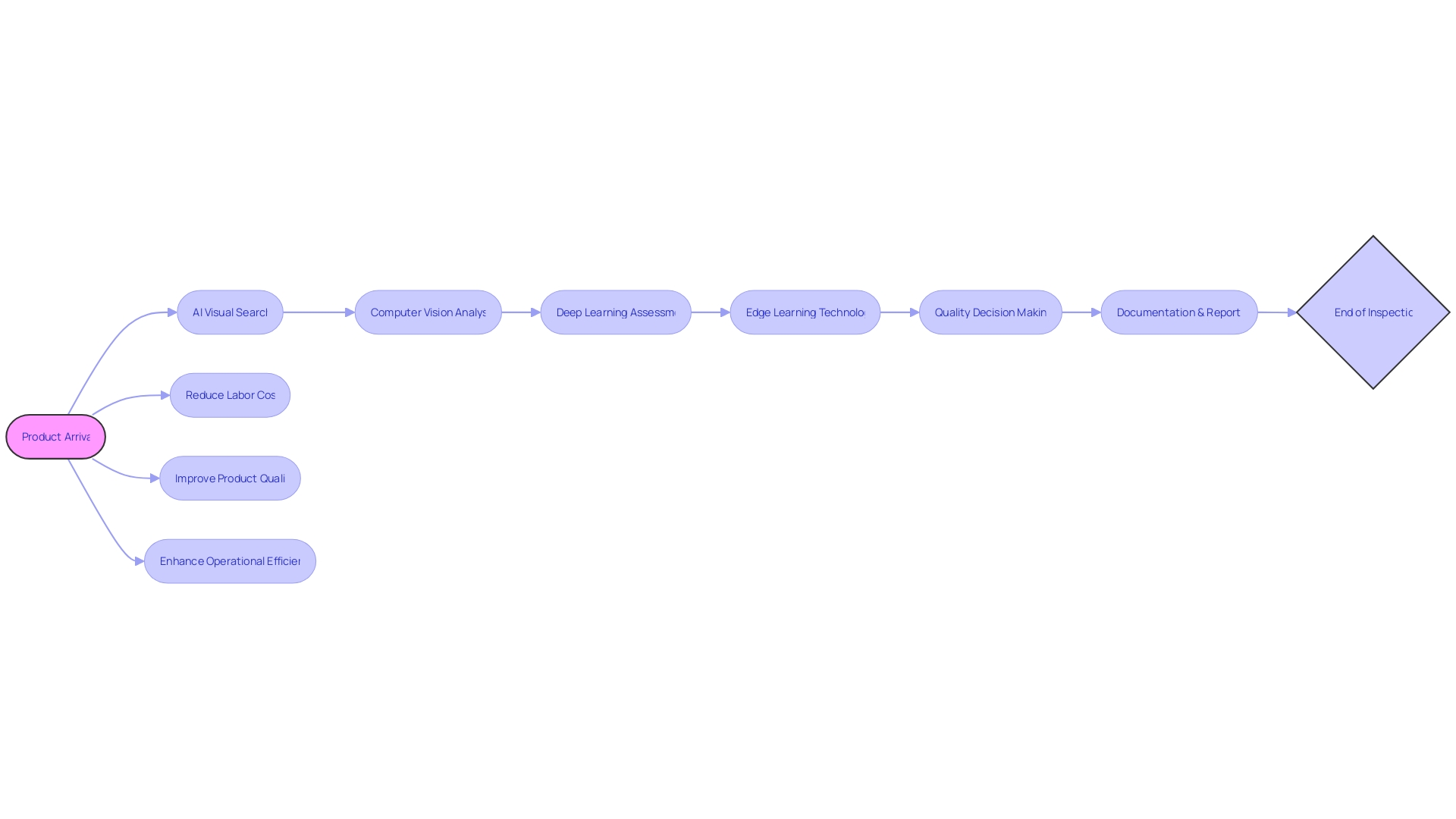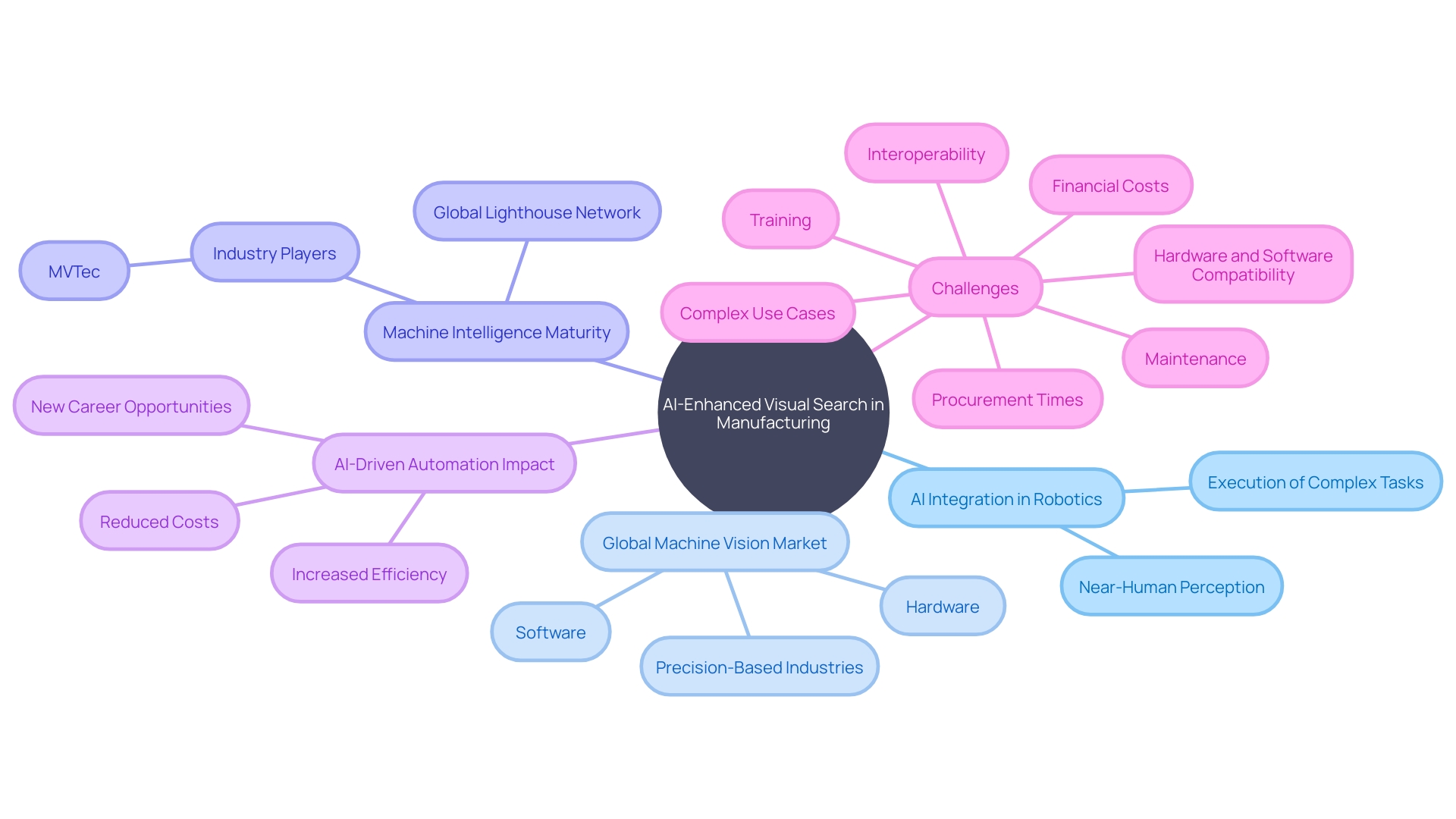Introduction
AI-enhanced visual search is revolutionizing various aspects of the manufacturing industry, from quality control and inspection to predictive maintenance, assembly line automation, inventory management, safety and compliance, and robotics and automation integration. This advanced technology, powered by AI and computer vision, is streamlining workflows, improving product quality, reducing costs, and propelling the industry toward the next industrial revolution. In this article, we will explore the transformative power of AI in manufacturing and its impact on operational efficiency, product quality, and overall competitiveness.
Quality Control and Inspection
AI-enhanced visual search is becoming indispensable in the manufacturing landscape, particularly in quality control and inspection processes. This advanced technology, encompassing computer vision and deep learning, empowers manufacturers to swiftly pinpoint and rectify defects, ensuring products meet the highest standards of quality. A leading global manufacturer's deployment of automated visual inspections exemplifies this shift, achieving a labor cost reduction of at least 80%, underscoring the profound impact of AI on operational efficiency.
The process of AI-driven quality inspection is intricate and methodical, encompassing a six-step journey from the moment products arrive for evaluation to the final documentation stage. It's a testament to how AI can streamline workflows and diminish the reliance on traditional manual inspection methods, which are often labor-intensive and less accurate. For example, the use of Vaira by Pleora, an AI-based visual inspection app, has markedly enhanced the ability of a distributor of OEM and aftermarket parts to expedite the identification and dispatch of the correct replacement products, thereby improving customer satisfaction and reducing turnaround times.
The integration of edge learning technology in machine vision systems further refines the inspection process. It adeptly identifies and categorizes defects while discerning between genuine flaws and acceptable variances, addressing the limitations of rule-based systems in complex inspection scenarios. Such nuanced capabilities are crucial in diverse applications, ranging from automotive parts to medical devices, where precision is paramount.
As the manufacturing sector evolves, the adoption of AI-driven quality control is not just a trend but a strategic move towards a more resilient and competitive business model. It harnesses real-time intelligence, reduces false positives in machine vision inspections, and leverages data to guide automation strategies. The transformative power of AI in manufacturing is clear, fostering not only enhanced product quality but also propelling the industry toward the next industrial revolution—Industry 4.0.

Predictive Maintenance
The industrial landscape has significantly evolved with the advent of AI, especially in the domain of predictive maintenance and product quality control. In 2024, AI-enhanced visual search is transforming the way manufacturing industries approach maintenance strategies.
By integrating AI with machine vision, manufacturers can now preemptively identify signs of deterioration in machinery, ensuring timely maintenance and reducing the incidence of unexpected breakdowns. This proactive methodology is a departure from traditional reactive maintenance, which is often associated with increased downtime and higher costs.
For instance, employees can now simply snap a photo of a needed spare part, and AI-driven image recognition systems can quickly and accurately identify it, streamlining day-to-day operations and inventory management. This fusion of AI with visual search capabilities not only expedites the identification process but also mitigates the risk of human error and inventory mismanagement, which can lead to costly delays. In the words of industry experts, this technological synergy is heralding a 'Fourth Industrial Revolution' or 'Industry 4.0', where the boundaries of machine efficiency and productivity are constantly being redefined.
Assembly Line Automation
Advancements in artificial intelligence (AI) are revolutionizing the realm of automated assembly lines, where precision and efficiency are paramount. AI-enhanced visual search has become an indispensable tool in modern manufacturing, empowering robots with the acuity to flawlessly identify components, ensuring parts are correctly aligned and instantly detecting any deviations.
These intelligent systems are adept at verifying the presence or absence of parts, precisely measuring assembly dimensions, and accurately directing robotic arms to the exact location of items. Moreover, they are capable of interpreting both 1D and 2D codes, thus streamlining the production process.
In scenarios where manual assembly is inevitable, AI-driven visual inspection systems are instrumental in quality assurance. They scrutinize the selection of components, confirming the correct parts are utilized in the proper sequence, which is critical for the final product to pass stringent quality checks.
Paired with interactive displays, these systems can guide assemblers through each step, alerting them to any missteps in real time. The manufacturing industry is witnessing a keen interest in integrating AI to refine vision inspection and reduce false positives that traditional machine vision might overlook.
Manufacturers who have yet to deploy vision systems are now exploring AI as a means to rectify error-prone processes and collect data that informs automation strategies. The global machine vision market, despite a temporary dip in 2023, is projected to resume growth in 2024, with expectations of a resurgence aligned with broader manufacturing and machinery production expansion. As AI continues to permeate the manufacturing sector, it's becoming clear that ease-of-use and no-code solutions are at the forefront of this technological wave. These advancements are not just about simplifying processes but also about enhancing the capabilities of vision systems to meet the diverse and complex demands of modern manufacturing. The industry is increasingly embracing 3D imaging solutions for robotic guidance, a testament to the maturation of 3D technology in automated imaging.
Inventory Management and Tracking
As AI technology advances, its integration into manufacturing processes is becoming increasingly vital. A striking example is the use of AI-enhanced visual search to streamline inventory management, as seen with the application of Vaira by Pleora.
This AI-based visual inspection app assists in accurately identifying and dispatching the correct replacement parts, significantly reducing the burden on customer service teams and improving turnaround times for replacements. The manufacturing sector is poised to generate an impressive 1,812 petabytes of data annually, outpacing several other industries.
This burgeoning volume of data underscores the importance of AI in managing complex production processes and adhering to Industry 4.0 standards. With the backing of governments and collaborations between academia and industry, the European robotics market is experiencing robust growth across various sectors.
AI's applications in manufacturing are diverse, with predictive maintenance, product modeling, quality monitoring, and supply chain management being pivotal areas. Innovations like the Vision platform from Standard AI, which extends to various store sections for inventory management without infringing on privacy, exemplify the practical benefits of AI in retail.
Meanwhile, the Seattle-based retailer's checkout-free experience, powered by Amazon's Just Walk Out technology, represents another leap forward. Industry experts recognize the shift in manufacturers' understanding of AI's potential. As noted by Goffin, companies are now looking to AI to refine vision inspection processes and guide automation strategies. This strategic deployment of AI is set to redefine efficiency and productivity, with 37% of supply chain organizations already witnessing its advantages. However, the expansion of AI applications hinges on the quality of data, its integration, and governance, with inadequate data quality, weak integration, and governance posing significant challenges.
Safety and Compliance
In the realm of manufacturing, AI-enhanced visual search is revolutionizing the way safety and compliance are managed. Advanced computer vision technology, powered by AI, is enabling manufacturers to identify potential hazards, oversee employee conduct, and maintain strict adherence to safety protocols.
This innovation in visual search is not only improving safety measures but also streamlining quality control processes. AI-driven quality inspection, for example, is a comprehensive, multistage procedure that guarantees both precision and efficiency in product assessment, resulting in significant time savings and enhanced product quality.
The machine vision market, which includes these AI technologies, is segmented into various components such as cameras, frame grabbers, optics, LED lighting, and processors, alongside software that ranges from application-specific to deep learning solutions. Innovations like Cognex's edge learning technology represent a balance between traditional rule-based machine vision systems and the dynamic capabilities of AI, allowing for on-device processing and real-time defect detection.
Recent breakthroughs, such as the AI technology for robot work developed by the Korea Institute of Machinery and Materials, are set to expand the scope of AI applications in manufacturing. This technology, based on Large Language Models, enables robots to understand user commands and execute complex tasks, promising substantial improvements in the working environment of manufacturing sites. With 83 percent of manufacturers anticipating that smart factory solutions will transform production within five years, computer vision stands at the forefront of this evolution. As AI continues to penetrate the manufacturing industry, it holds the promise of innovating safety measures, enhancing efficiency, and fostering a new era of compliance and quality control.
Robotics and Automation Integration
In the vanguard of the manufacturing sector, AI-enhanced visual search technology is transforming the capabilities of robotics and automation. This innovative approach imbues machines with a near-human level of perception, empowering them to recognize and interpret their surroundings with remarkable precision. The fusion of Artificial Intelligence and robotics is not merely about equipping robots with smarter capabilities; it's about integrating AI into the core of robotic systems, unlocking new dimensions of functionality.
For instance, Ai's real-time monitoring can adjust maintenance schedules on-the-fly based on predictive wear forecasting, revolutionizing the efficiency of maintenance protocols. Moreover, this technology enables robots to dynamically plan and execute complex tasks, such as overseeing automated assembly lines, while ensuring seamless collaboration and safety alongside human workers. The Global Machine Vision Market, which encompasses these AI applications, is segmented into various components such as hardware (including cameras, frame grabbers, optics, LED lighting, and processors) and software (ranging from application-specific to deep learning software).
This market is instrumental in industries where precision and reliability are paramount, such as battery production and semiconductor manufacturing. Here, machine vision's high speed, accuracy, and constant availability offer substantial advantages. Furthermore, the Global Lighthouse Network illustrates the burgeoning maturity of machine intelligence technologies, with leading companies scaling their AI applications across entire factories.
These advancements are not confined to theoretical applications; they are tangible and emergent, evidenced by the enthusiastic participation of industry players like MVTec at trade fairs such as Automate. Dr. Olaf Munkelt, MVTec's Managing Director, emphasizes that machine vision is the 'eye of production,' a cornerstone of modern automation that is utilized across a broad spectrum of industries. The machine vision market, though fragmented, is witnessing a surge of new entrants, particularly from China, signaling a global embrace of AI-driven automation that will continue to redefine manufacturing operations.

Conclusion
In conclusion, AI-enhanced visual search is revolutionizing manufacturing. It streamlines workflows, improves product quality, and reduces costs. This technology replaces manual inspection methods and ensures products meet high-quality standards.
AI-driven visual search enables preemptive maintenance by identifying signs of machinery deterioration, reducing breakdowns. It expedites inventory management by accurately identifying spare parts through photos. In assembly line automation, AI-powered systems flawlessly identify components and detect deviations, enhancing quality assurance in both automated and manual processes.
Integrating AI into inventory management optimizes replacement part identification and reduces turnaround times. It also extends to predictive maintenance, product modeling, quality monitoring, supply chain management, and safety protocols. The fusion of AI and robotics empowers machines with precise perception abilities while collaborating safely with human workers.
Overall, AI-enhanced visual search propels manufacturing towards a competitive future with enhanced efficiency and compliance with Industry 4.0 standards. By embracing this transformative technology, manufacturers can stay ahead in an evolving industry landscape. The power of AI in manufacturing is clear - it improves workflows, enhances product quality, reduces costs, and drives the industry forward.





